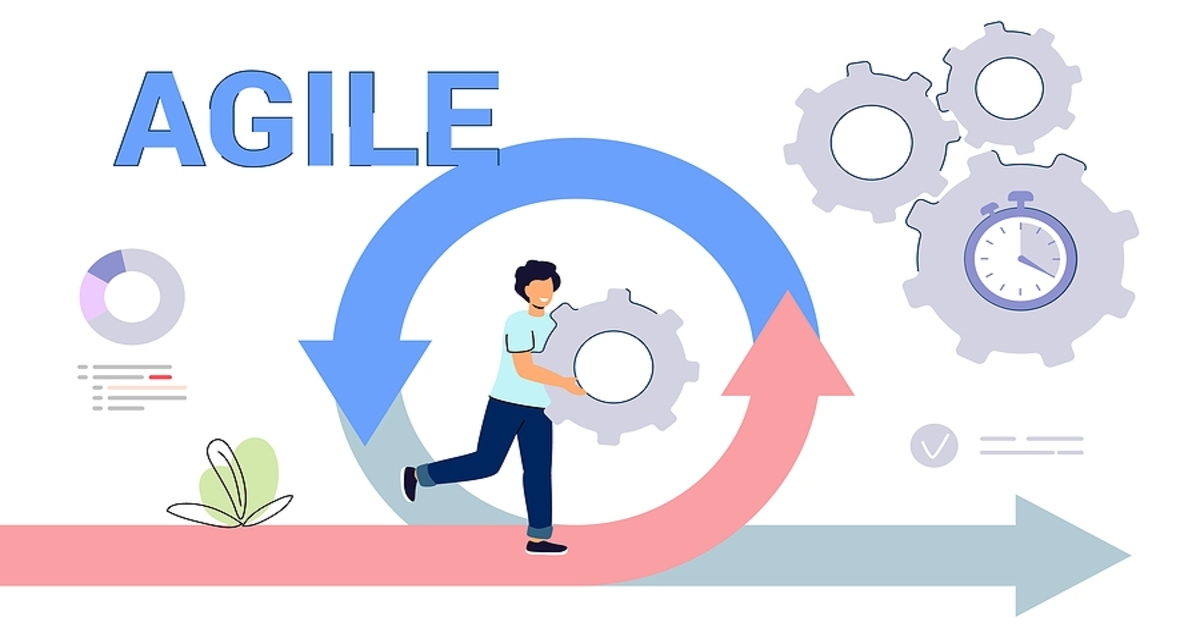In today’s rapidly evolving business landscape, the role of an Agile Business Analyst (BA) has become pivotal in driving successful product development.
As organizations increasingly adopt Agile methodologies, Business Analysts play a crucial role in bridging the gap between business objectives and technical implementation.
In this article, we’ll delve into the world of Agile Product Development and explore the best practices that empower Business Analysts to excel in their roles.

What Is Agile Product Development?
Agile Product Development is a flexible and collaborative way of creating things.
It involves working in small steps, learning and adapting as you go, and involving everyone on the team to make sure the final result meets the needs of the users and the goals of the project.
Embracing the Agile Mindset
In the fast-paced realm of Agile product development, the Agile mindset serves as a compass, guiding Business Analysts (BAs) through uncharted waters.
It’s not merely a set of rules to follow; it’s a transformative approach that shapes the very essence of how Agile business analysts interact with their agile teams, stakeholders, and the challenges that lie ahead.
Understanding Agile Principles and Agile Values
At the core of Agile methodology are twelve guiding principles, from customer collaboration to embracing change. These agile methodology principles form the bedrock of Agile methodologies. For Business Analysts, grasping them is like understanding Agile’s soul—where flexibility, adaptability, and customer satisfaction drive decisions.
Imagine an Agile project, changing requirements. You pivot, embodying “Welcome changing requirements,” adjusting the roadmap. Flexibility keeps the project on track, instilling stakeholder confidence. Agile methodology’s power shines.
Effective Communication and Collaboration
Effective communication and collaboration are the lifeblood that courses through the veins of every successful project. Business Analysts in an Agile environment aren’t just interpreters of requirements; they are masters of the art of connection—bridging gaps, fostering understanding, and creating a symphony of teamwork that resonates across the entire organization.

Communication Skills as a Cornerstone for Success
Picture this: You’re a Business Analyst in a dynamic project team. Each member brings unique expertise, forming a diverse tapestry. Amidst this, your communication prowess stands out. You effortlessly translate complex tech jargon into insights, bridging gaps between stakeholders. As discussions flow, requirements emerge, and updates are conveyed, your words break barriers.
Developer, designer, or stakeholder—all understand. Your active listening captures not just words, but intent. When a developer raises concerns, you discern hidden hurdles. Through your adept communication, challenges turn to progress, paving the way forward.
Collaborating with Cross-Functional Agile Teams
In Agile methodology, diverse skills converge like a bustling marketplace. As an Agile Business Analyst, you’re a cross-functional chameleon. You bridge designers and developers, shape market appeal with marketers, and collaborate effectively and closely with testers.
More than requirements, you cultivate unity, inspiring the team’s shared purpose. This synergy is Agile’s magic, turning ideas into reality.
Working closely with a Product Owner, Development Team, and Stakeholders
As an Agile Business Analyst, you connect diverse stakeholders. Picture this: In a meeting room, surrounded by owners, developers, and stakeholders, you spark dialogue. Your probing questions fuel conversations, clarifying needs and visions.
Beyond meetings, you’re the team’s glue—guiding sprint planning, refining stories, and celebrating progress. Your collaboration breaks silos, amplifying voices and ensuring collective victories.
Business Analysis in Agile Methodology
Agile Business Analysts are the choreographers, orchestrating the harmonious interplay between business needs and technical implementation. As the architects of requirements, BAs don’t just collect demands; they craft a symphony of user-centric solutions that resonate with both stakeholders and development teams.

Adapting Traditional Business Analysis Techniques for Agile Projects
Picture this: You’re a seasoned Business Analyst, well-versed in traditional requirements-gathering methods. Now, you find yourself in the realm of Agile—where change is constant, and flexibility reigns supreme. Here, your adaptability shines as you seamlessly transition your toolkit.
Gone are the exhaustive documentation marathons. Instead, you opt for lightweight artifacts that convey the essence of requirements. You embrace collaborative workshops, eliciting insights from stakeholders, developers, and designers alike. You recognize that an Agile entire project is like a canvas, constantly evolving. Your ability to swiftly pivot, embrace change, and extract valuable nuggets from chaos defines your success.
Creating User Stories and Acceptance Criteria
User stories—the heartbeats of Agile projects—are your canvas to paint intricate portraits of user experiences. With each user story, you encapsulate a persona, their goals, and the value they seek. You breathe life into these narratives, ensuring that the essence of the user’s journey is captured.
Imagine crafting a user story for a mobile banking app. “As a frequent traveler, I want to easily transfer funds between international accounts so that I can manage my finances on the go.” In this simple sentence, you encapsulate a user persona, their need, and the desired outcome.
But your artistry doesn’t stop at stories; it extends to acceptance criteria. Like a blacksmith forging the finest blade, you meticulously outline the conditions that define a feature’s completeness. “Given an international transfer request, when the user enters recipient details and confirms, then a confirmation message appears, and the transfer is logged in the user’s transaction history.”
Through user stories and acceptance criteria, you craft a shared understanding—a blueprint that guides development and ensures that every line of code weaves the fabric of user satisfaction.
Translating Business Needs into Actionable Requirements
In Agile’s marketplace, the needs of a business are currency, and you—the Agile Business Analyst—are the interpreter. Stakeholder conversations peel back layers, revealing desires and true needs. Like a detective, you uncover motivations. A “quick checkout process” becomes a frictionless user experience.
You turn needs into actionable requirements, guiding a streamlined checkout system. In Agile Business Analysis, you’re an alchemist—turning needs into gold, enriching experiences, and achieving the project’s success.
Supporting the Agile Development Process
As the backbone of an Agile project, BAs lend their expertise to ensure that the development process is not just a sequence of tasks but a strategic journey toward delivering exceptional value. Let’s see what is the business analyst role in Agile first:

The Agile Business Analyst Role
Imagine the Agile development journey as a bustling marketplace, where each stall represents a sprint—a time-bound iteration that ushers in new features and enhancements. At the heart of this marketplace stands the Agile Business Analyst, orchestrating the flow of requirements, aligning the agile team with business goals, and ensuring that the delivered software aligns with the organization’s vision.
Your role is that of a conductor, harmonizing the efforts of designers, developers, and testers to create a symphony of innovation. You facilitate conversations, capture feedback, and channel it into a coherent melody of user stories and features that resonate with stakeholders.
Analyzing Business Requirements and Contributing to the Product Backlog
Just as a chef meticulously selects ingredients for a gourmet dish, you, the Agile Business Analyst, meticulously analyze and prioritize business requirements. You dissect each need, assessing its potential impact, complexity, and alignment with strategic objectives.
These insights shape the Product Backlog—a dynamic repository of ideas and features awaiting their turn in the spotlight. You curate this backlog, ensuring that each entry is not just a wish but a well-defined requirement that adds measurable value.
Ensuring Alignment Between Business Objectives and Agile Processes
In the grand tapestry of Agile projects, every thread represents a business objective—a strategic goal that propels the organization forward. Your role is to weave these threads seamlessly into the Agile fabric, ensuring that each sprint stitches together features that contribute to the bigger picture.
Imagine a puzzle where each piece represents a sprint goal. Your expertise ensures that as each piece falls into place, the final image aligns with the organization’s vision. Through constant collaboration with stakeholders, product owners, and development teams, you champion the cause of alignment, translating high-level goals into actionable steps.
In this dynamic landscape, you are the North Star, guiding the team’s efforts toward a destination defined by business value and user satisfaction.
Key Skills for Agile Business Analysts
Business Analysts (BAs) don’t just play a role; they wield a diverse set of skills that shape the very trajectory of projects. Agile BAs are not merely conduits for requirements; they are catalysts for innovation, using their expertise to bridge the gap between business needs and technical execution.
Here, we uncover the important skills that transform the agile business analyst into a true navigator of value.

Analytical Skills for Effective Problem-Solving
Imagine a puzzle—the pieces scattered, each representing a complex business challenge. An agile business analyst possesses a unique knack for piecing together these intricate elements, forming a cohesive picture of solutions. He analyzes requirements from every angle, distilling them into actionable steps that guide development.
Picture this: A stakeholder expresses the need for a data visualization feature. Through keen analysis, you discern that the underlying challenge is not just data representation but enabling data-driven decision-making. Your analytical prowess leads you to propose a comprehensive solution—a dashboard that not only displays data but also empowers users with insights.
Negotiation Skills to Prioritize and Manage Expectations
An agile business analyst dons the hat of a negotiator, gracefully navigating the delicate dance between stakeholders’ desires and development constraints. It’s a realm where every decision carries weight, where every feature competes for attention.
Imagine a sprint planning session. Stakeholders advocate for a myriad of features, each believing their request holds paramount importance. Here, your negotiation finesse shines. You facilitate discussions, presenting the team’s capacity and the potential impact of each feature. Through strategic negotiation, you align expectations, ensuring that the chosen features maximize value within the sprint’s confines.
Understanding Market Analysis to Drive Business Value
In the bustling marketplace of software development, agile business analyst does not just craft features; they sculpt solutions that resonate with the market’s pulse. Armed with a deep understanding of market trends and customer needs, they steer projects toward outcomes that transcend technical brilliance.
Envision this: A new mobile app is in the works, aiming to revolutionize remote work. Here, your market analysis skills come into play. You study competing solutions, identify gaps in the market, and propose features that cater to unmet needs. Through your insights, the app doesn’t just meet expectations; it becomes a game-changer in a crowded landscape.
In the world of Agile Business Analysis, these skills aren’t just tools; they’re the sparks that ignite innovation, the threads that weave together disparate elements, and the compass that guides projects toward success.
Evolving as an Agile Business Analyst
As the Agile world evolves, so must the skills and knowledge of an agile business analyst. Here, we delve into the journey of perpetual improvement that defines the Agile BA’s path.

Continuous Learning and Professional Development
Imagine an agile business analyst as a sponge, constantly absorbing knowledge, trends, and innovations. This insatiable thirst for learning propels BAs forward, enabling them to adapt to changing landscapes and emerging technologies.
From devouring the latest industry publications to attending workshops and webinars, the agile business analyst is a lifelong learner. They remain curious, exploring new methodologies, tools, and strategies that enrich their toolkit. This commitment to growth ensures that the Agile BA remains at the forefront of industry developments.
Obtaining Certifications (e.g., Certified Scrum Product Owner)
Certifications are the badges of expertise that an agile business analyst wears proudly. Earning certifications such as Certified Scrum Product Owner (CSPO) signifies a mastery of Agile principles and practices. It’s more than just a piece of paper; it’s a testament to dedication and proficiency.
Picture an agile business analyst with a CSPO certification. They don’t just understand Agile; they embody it. They navigate the Agile seas with confidence, leveraging their certification-backed knowledge to guide projects and agile teams toward success.
Becoming a Valuable Asset Through Diverse Business Knowledge
An agile business analyst is not one-dimensional; He is a polymath of the business world. They don’t just analyze; they understand the intricacies of various domains. They’re not just spectators; they actively contribute to discussions on marketing, finance, and operations.
Imagine an agile business analyst collaborating with stakeholders across industries. Their diverse business knowledge allows them to translate business needs into actionable requirements that resonate with every corner of the organization. Their insights make them indispensable, transforming them into strategic advisors rather than mere analysts.
As the Agile landscape evolves, so does the Agile BA. Their commitment to continuous learning, certifications, and broad business acumen propels them forward, ensuring they remain invaluable assets in an ever-changing world.
Agile Business Analyst’s Contribution to the Agile Team
In Agile product development, the Agile Business Analyst (BA) isn’t just a translator; they’re a catalyst for collaboration and value creation.
Imagine an agile business analyst as a bridge—a connector between business stakeholders and the development team. They distill complex requirements into actionable insights, fostering alignment and transforming disjointed efforts into synchronized progress.
But the agile business analyst isn’t just a communicator; they’re a contributor. They infuse user stories with purpose, guiding the agile team toward impactful solutions.
As an active agile team member, an agile business analyst leverages his domain knowledge to offer insights and prevent challenges. He is the compass guiding the agile team toward user satisfaction and business value.
In Agile, the agile business analyst is a lead performer, embodying collaboration, adaptation, and value creation.

The Agile Business Analyst Salary
In Agile product development, the Agile Business Analyst (BA) earns more than respect—they earn rewarding compensation. Let’s delve into Agile BA salaries, exploring factors that influence earnings, average ranges, and exciting growth potential.
Imagine the Agile BA’s salary as a reflection of their Agile mastery, communication skills, and role in bridging business and development.
Factors include key responsibilities, industry demand, location, and experience. As Agile methods expand, the demand for skilled Agile BAs rises, valuing their unique abilities.
The average salary varies, from entry-level to seasoned pros. Possibilities for advancement are exhilarating. As an Agile BA contributes to project success, he can rise to leadership roles, guiding teams and strategies.
In the Agile realm, salaries mirror value. An Agile business analyst is a navigator, innovator, and collaborator. As Agile evolves, so do their opportunities for growth.

Conclusion
The Agile Business Analyst is the architect of success in Agile product development.
Their fusion of Agile principles, communication, and analytical skills creates an innovative symphony that resonates with stakeholders and teams.
From mindset to solutions, an agile business analyst embodies collaboration and value. He is the heartbeat of projects, enabling innovation and excellence.
As we conclude our exploration of Agile Best Practices for Business Analysts, remember this: An Agile BA is not just a contributor; he is a pioneer of success. His journey, much like Agile, is a perpetual voyage of discovery and achievement.
In Agile’s evolving landscape, one thing is certain: An Agile business analyst will continue to redefine possibilities, fueled by their commitment, strong problem-solving skills, and adaptability.
Their impact on projects is a testament to their invaluable role and the enduring legacy of Agile.

People Also Ask (FAQs)
What is the role of an Agile Business Analyst in product development?
An Agile Business Analyst (BA) plays a pivotal role in bridging the gap between business needs and technical execution. They ensure clear communication, translate requirements into user stories, and foster collaboration among cross-functional Agile teams.
How does an Agile Business Analyst contribute to project success?
An agile business analyst contributes by aligning business objectives with Agile processes, crafting user-centric solutions, and ensuring effective communication. He analyzes business requirements, prioritizes features, and creates a shared understanding that drives value and innovation.
What skills are essential for an Agile Business Analyst?
An Agile BA requires strong analytical skills for effective problem-solving, negotiation skills to manage expectations, and a deep understanding of market analysis to drive business value. Continuous learning, adaptability, and the ability to create impactful user stories are also crucial skills.
How does an Agile Business Analyst contribute to the development team in Agile product development?
An Agile Business Analyst plays a pivotal role in bridging the gap between business stakeholders and the development team. They translate requirements into user stories, ensuring a shared understanding and guiding the team toward creating valuable software solutions.



